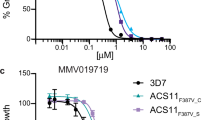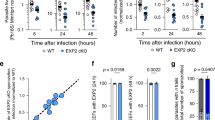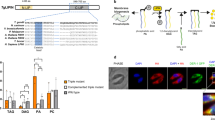Abstract
Although there have been numerous advances in our understanding of how apicomplexan parasites such as Toxoplasma gondii enter host cells, many of the signaling pathways and enzymes involved in the organization of invasion mediators remain poorly defined. We recently performed a forward chemical-genetic screen in T. gondii and identified compounds that markedly enhanced infectivity. Although molecular dissection of invasion has benefited from the use of small-molecule inhibitors, the mechanisms underlying induction of invasion by small-molecule enhancers have never been described. Here we identify the Toxoplasma ortholog of human APT1, palmitoyl protein thioesterase-1 (TgPPT1), as the target of one class of small-molecule enhancers. Inhibition of this uncharacterized thioesterase triggered secretion of invasion-associated organelles, increased motility and enhanced the invasive capacity of tachyzoites. We demonstrate that TgPPT1 is a bona fide depalmitoylase, thereby establishing an important role for dynamic and reversible palmitoylation in host-cell invasion by T. gondii.
This is a preview of subscription content, access via your institution
Access options
Subscribe to this journal
Receive 12 print issues and online access
$259.00 per year
only $21.58 per issue
Buy this article
- Purchase on Springer Link
- Instant access to full article PDF
Prices may be subject to local taxes which are calculated during checkout





Similar content being viewed by others
References
Sibley, L.D. Intracellular parasite invasion strategies. Science 304, 248–253 (2004).
Hall, C.I. et al. Chemical genetic screen identifies Toxoplasma DJ-1 as a regulator of parasite secretion, attachment, and invasion. Proc. Natl. Acad. Sci. USA 108, 10568–10573 (2011).
Arrizabalaga, G. & Boothroyd, J.C. Role of calcium during Toxoplasma gondii invasion and egress. Int. J. Parasitol. 34, 361–368 (2004).
Billker, O., Lourido, S. & Sibley, L.D. Calcium-dependent signaling and kinases in apicomplexan parasites. Cell Host Microbe 5, 612–622 (2009).
Roos, D.S., Donald, R.G., Morrissette, N.S. & Moulton, A.L. Molecular tools for genetic dissection of the protozoan parasite Toxoplasma gondii. Methods Cell Biol. 45, 27–63 (1994).
Keeley, A. & Soldati, D. The glideosome: a molecular machine powering motility and host-cell invasion by Apicomplexa. Trends Cell Biol. 14, 528–532 (2004).
Carruthers, V.B., Giddings, O.K. & Sibley, L.D. Secretion of micronemal proteins is associated with Toxoplasma invasion of host cells. Cell. Microbiol. 1, 225–235 (1999).
Soldati, D., Dubremetz, J.F. & Lebrun, M. Microneme proteins: structural and functional requirements to promote adhesion and invasion by the apicomplexan parasite Toxoplasma gondii. Int. J. Parasitol. 31, 1293–1302 (2001).
Carruthers, V.B. & Sibley, L.D. Mobilization of intracellular calcium stimulates microneme discharge in Toxoplasma gondii. Mol. Microbiol. 31, 421–428 (1999).
Lourido, S. et al. Calcium-dependent protein kinase 1 is an essential regulator of exocytosis in Toxoplasma. Nature 465, 359–362 (2010).
Carruthers, V.B., Sherman, G.D. & Sibley, L.D. The Toxoplasma adhesive protein MIC2 is proteolytically processed at multiple sites by two parasite-derived proteases. J. Biol. Chem. 275, 14346–14353 (2000).
Huynh, M.H. & Carruthers, V.B. Toxoplasma MIC2 is a major determinant of invasion and virulence. PLoS Pathog. 2, e84 (2006).
Black, M.W., Arrizabalaga, G. & Boothroyd, J.C. Ionophore-resistant mutants of Toxoplasma gondii reveal host cell permeabilization as an early event in egress. Mol. Cell. Biol. 20, 9399–9408 (2000).
Heynekamp, J.J. et al. Isocoumarin-based inhibitors of pancreatic cholesterol esterase. Bioorg. Med. Chem. 16, 5285–5294 (2008).
Powers, J.C. et al. Mechanism-based isocoumarin inhibitors for serine proteases: use of active site structure and substrate specificity in inhibitor design. J. Cell. Biochem. 39, 33–46 (1989).
Liu, Y., Patricelli, M.P. & Cravatt, B.F. Activity-based protein profiling: the serine hydrolases. Proc. Natl. Acad. Sci. USA 96, 14694–14699 (1999).
Haedke, U., Gotz, M., Baer, P. & Verhelst, S.H. Alkyne derivatives of isocoumarins as clickable activity-based probes for serine proteases. Bioorg. Med. Chem. 20, 633–640 (2012).
Weerapana, E., Speers, A.E. & Cravatt, B.F. Tandem orthogonal proteolysis-activity-based protein profiling (TOP-ABPP)—a general method for mapping sites of probe modification in proteomes. Nat. Protoc. 2, 1414–1425 (2007).
Duncan, J.A. & Gilman, A.G. A cytoplasmic acyl-protein thioesterase that removes palmitate from G protein α subunits and p21(RAS). J. Biol. Chem. 273, 15830–15837 (1998).
Santos, J.M., Hedberg, C. & Soldati-Favre, D. Protein acylation: new potential targets for intervention against the apicomplexa in Apicomplexan Parasites: Molecular Approaches Toward Targeted Drug Development Vol. 2 (eds. Becker, K. & Selzer, P.M.) 335–357 (Wiley-Blackwell, 2011).
Herm-Götz, A. et al. Rapid control of protein level in the apicomplexan Toxoplasma gondii. Nat. Methods 4, 1003–1005 (2007).
Dekker, F.J. et al. Small-molecule inhibition of APT1 affects Ras localization and signaling. Nat. Chem. Biol. 6, 449–456 (2010).
Fox, B.A., Ristuccia, J.G., Gigley, J.P. & Bzik, D.J. Efficient gene replacements in Toxoplasma gondii strains deficient for nonhomologous end-joining. Eukaryot. Cell 8, 520–529 (2009).
Duncan, J.A. & Gilman, A.G. Characterization of Saccharomyces cerevisiae acyl-protein thioesterase 1, the enzyme responsible for G protein α subunit deacylation in vivo. J. Biol. Chem. 277, 31740–31752 (2002).
Lourido, S., Tang, K. & Sibley, L.D. Distinct signalling pathways control Toxoplasma egress and host-cell invasion. EMBO J. 31, 4524–4534 (2012).
Rees-Channer, R.R. et al. Dual acylation of the 45 kDa gliding-associated protein (GAP45) in Plasmodium falciparum merozoites. Mol. Biochem. Parasitol. 149, 113–116 (2006).
Frénal, K. et al. Functional dissection of the apicomplexan glideosome molecular architecture. Cell Host Microbe 8, 343–357 (2010).
Martin, B.R., Wang, C., Adibekian, A., Tully, S.E. & Cravatt, B.F. Global profiling of dynamic protein palmitoylation. Nat. Methods 9, 84–89 (2012).
Garrison, E. et al. A forward genetic screen reveals that calcium-dependent protein kinase 3 regulates egress in Toxoplasma. PLoS Pathog. 8, e1003049 (2012).
McCoy, J.M., Whitehead, L., van Dooren, G.G. & Tonkin, C.J. TgCDPK3 regulates calcium-dependent egress of Toxoplasma gondii from host cells. PLoS Pathog. 8, e1003066 (2012).
Beck, J.R. et al. A Toxoplasma palmitoyl acyl transferase and the palmitoylated Armadillo Repeat protein TgARO govern apical rhoptry tethering and reveal a critical role for the rhoptries in host cell invasion but not egress. PLoS Pathog. 9, e1003162 (2013).
Mueller, C. et al. The Toxoplasma protein ARO mediates the apical positioning of rhoptry organelles, a prerequisite for host cell invasion. Cell Host Microbe 13, 289–301 (2013).
Prescott, G.R., Gorleku, O.A., Greaves, J. & Chamberlain, L.H. Palmitoylation of the synaptic vesicle fusion machinery. J. Neurochem. 110, 1135–1149 (2009).
Del Carmen, M.G., Mondragon, M., Gonzalez, S. & Mondragon, R. Induction and regulation of conoid extrusion in Toxoplasma gondii. Cell. Microbiol. 11, 967–982 (2009).
Carey, K.L., Westwood, N.J., Mitchison, T.J. & Ward, G.E. A small-molecule approach to studying invasive mechanisms of Toxoplasma gondii. Proc. Natl. Acad. Sci. USA 101, 7433–7438 (2004).
Kremer, K. et al. An overexpression screen of Toxoplasma gondii Rab-GTPases reveals distinct transport routes to the micronemes. PLoS Pathog. 9, e1003213 (2013).
Jones, M.L., Collins, M.O., Goulding, D., Choudhary, J.S. & Rayner, J.C. Analysis of protein palmitoylation reveals a pervasive role in Plasmodium development and pathogenesis. Cell Host Microbe 12, 246–258 (2012).
Alonso, A.M. et al. Protein palmitoylation inhibition by 2-bromopalmitate alters gliding, host cell invasion and parasite morphology in Toxoplasma gondii. Mol. Biochem. Parasitol. 184, 39–43 (2012).
Hirakawa, S., Saito, R., Ohara, H., Okuyama, R. & Aiba, S. Dual oxidase 1 induced by TH2 cytokines promotes STAT6 phosphorylation via oxidative inactivation of protein tyrosine phosphatase 1B in human epidermal keratinocytes. J. Immunol. 186, 4762–4770 (2011).
Speers, A.E. & Cravatt, B.F. Activity-based protein profiling (ABPP) and click chemistry (CC)-ABPP by MudPIT mass spectrometry. Curr. Protoc. Chem. Biol. 1, 29–41 (2009).
Huynh, M.H. & Carruthers, V.B. Tagging of endogenous genes in a Toxoplasma gondii strain lacking Ku80. Eukaryot. Cell 8, 530–539 (2009).
Lodoen, M.B., Gerke, C. & Boothroyd, J.C. A highly sensitive FRET-based approach reveals secretion of the actin-binding protein toxofilin during Toxoplasma gondii infection. Cell. Microbiol. 12, 55–66 (2010).
Donald, R.G. & Roos, D.S. Gene knock-outs and allelic replacements in Toxoplasma gondii: HXGPRT as a selectable marker for hit-and-run mutagenesis. Mol. Biochem. Parasitol. 91, 295–305 (1998).
Acknowledgements
We thank the Bogyo and Boothroyd labs for discussions that shaped the direction of the project; G. Ward (University of Vermont) for discussions and the GAP45 antibody; B. Martin for discussions regarding the 17-ODA metabolic labeling experiments; G. Arrizabalaga (Indiana University) and M. Treeck (Stanford University) for the TgCDPK3-HA parasite line; B. Cravatt (Scripps Research Institute) for FP-rho; T. Wandless (Stanford University) for Shield-1; and the Stanford high-throughput imaging facility for assistance with imaging the attachment and invasion assays. This work was funded by a Burroughs Wellcome Trust New Investigators in Pathogenesis Award (to M.B.), by the US National Institutes of Health grants R01-AI078947 and EB005011 (to M.B.) and RO1 AI21423 (to J.C.B.).
Author information
Authors and Affiliations
Contributions
M.A.C. designed and performed the majority of the experiments, analyzed the data, generated the figures and wrote the manuscript. C.I.H. performed the original high-throughput screen and various biochemical and cell biological studies. C.I.H., V.E.A. and P.W.B. characterized the enhancer phenotype. V.E.A. synthesized JCP174-IA and JCP174-alk. J.C.P. and L.O.O. synthesized JCP174, JCP222 and JCP362. J.R.B. generated the TgPPT1-HAdd parasite line under the supervision of P.J.B. M.G. contributed to the CDPK3 experiments. E.W. performed MS experiments. E.W. and J.C.B. intellectually contributed to the decision to pursue TgPPT1 as the functionally relevant target of JCP174. M.B. supervised the project, designed and analyzed experiments and wrote parts of the manuscript.
Corresponding author
Ethics declarations
Competing interests
The authors declare no competing financial interests.
Supplementary information
Supplementary Text and Figures
Supplementary Figures 1–11 and Supplementary Tables 3 and 4. (PDF 10179 kb)
Supplementary Tables 1 and 2
Suplementary Table 1: Mass spectrometry data of identified peptides from FP-Biotin labeling and TOP-ABPP using the JCP174-alk probe. Supplementary Table 2: List of the top 6 hits from the total list of identified targets of FP-Rho and JCP174-alk. (XLS 66 kb)
Supplementary Note
Supplementary Notes (PDF 1171 kb)
Rights and permissions
About this article
Cite this article
Child, M., Hall, C., Beck, J. et al. Small-molecule inhibition of a depalmitoylase enhances Toxoplasma host-cell invasion. Nat Chem Biol 9, 651–656 (2013). https://doi.org/10.1038/nchembio.1315
Received:
Accepted:
Published:
Issue Date:
DOI: https://doi.org/10.1038/nchembio.1315
This article is cited by
-
Comparative multi-omics analyses reveal differential expression of key genes relevant for parasitism between non-encapsulated and encapsulated Trichinella
Communications Biology (2021)
-
An in vivo multiplexed small-molecule screening platform
Nature Methods (2016)
-
Post-translational protein modifications in malaria parasites
Nature Reviews Microbiology (2015)
-
The Plasmodium palmitoyl-S-acyl-transferase DHHC2 is essential for ookinete morphogenesis and malaria transmission
Scientific Reports (2015)



